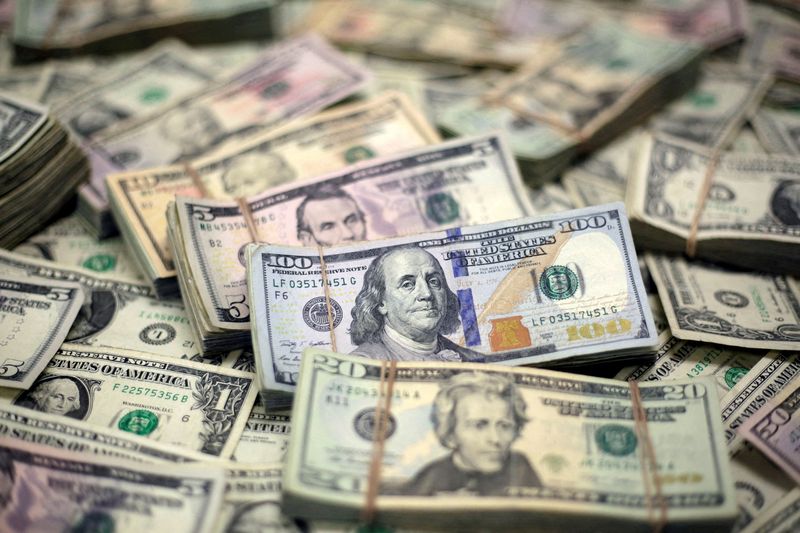Forex
US dollar drops to near 9-month low versus yen amid talk of larger Fed rate cut

(This Sept. 13 story has been refiled to remove Mellon in BNY company name in paragraph 8)
By Gertrude Chavez-Dreyfuss and Chibuike Oguh
NEW YORK (Reuters) – The U.S. dollar fell on Friday to its lowest level in nearly nine months against the Japanese yen after media reports once again fueled speculation the Federal Reserve could deliver a super-sized 50-basis-point interest rate cut at its policy meeting next week.
Analysts said reports by the Wall Street Journal and Financial Times late on Thursday saying a 50-bp rate reduction is still an option, and comments from a former Fed official arguing for an outsized cut, caused a shift in market expectations.
The U.S. rate futures market has priced in a 51% probability of a 50-bp easing by the Fed at the conclusion of its two-day meeting on Wednesday, up from about 15% early on Thursday. Futures traders have also factored in 117 bps of cuts for 2024, up from 107 bps in the previous session.
The media reports introduced the probability of a 50-bp cut back into the market after new inflation data had reinforced expectations of a 25-bp cut by the Fed, said Brad Bechtel, global head of FX at Jefferies in New York. “So you’re just seeing a little bit of an unwinding of those positions that were looking for 25 basis points.”
In late afternoon trading, the dollar was down 0.66% to 140.855 yen, after earlier dropping to 140.285, its lowest level since Dec. 28. On the week, it fell 1%.
The euro, meanwhile, rose 0.08% versus the greenback to $1.1083.
The European Central Bank cut interest rates by 25 bps on Thursday, but ECB President Christine Lagarde dampened expectations for another reduction in borrowing costs next month. Gains in the euro have pushed the 0.08% lower to 101.08.
“That increase in probabilities of potentially more dovish Fed policy drove the dollar lower and pushed a lot of those other currencies higher, said John Velis, FX and macro strategist at BNY in Boston.
The dollar trimmed losses after data showed U.S. consumer sentiment improved in September amid easing inflation.
The University of Michigan’s preliminary reading on the overall index of consumer sentiment came in at 69.0 this month, compared with a final reading of 67.9 in August. Economists polled by Reuters had forecast a preliminary reading of 68.5.
U.S. economic data this week appeared to support the case for a typical 25-bp cut next week, with the measure of consumer price inflation that strips out volatile food and energy prices rising more than expected in August.
But former New York Fed President Bill Dudley on Friday added to the speculation about a 50-bp Fed rate cut, saying there was a strong case for such a move and that rates were currently 150-200 basis points above the so-called neutral rate for the U.S. economy, where policy is neither restrictive nor accommodative. “Why don’t you just get started?,” he said.
The euro “is eyeing $1.11 again after the combined support of a not-dovish-enough European Central Bank and rising dovish bets on the Fed,” said Francesco Pesole, a currency strategist at ING.
Sterling edged slightly lower 0.01% to $1.31235, weakening after reaching near its highest level in a week. The Bank of England is expected to hold its key interest rate at 5% next week after kicking off its easing with a 25-bp reduction in August.
The dollar fell 0.38% against the Swiss franc to 0.84780 francs.
Investors were also looking to the Bank of Japan’s interest rate decision next Friday, when it is expected to keep its short-term policy rate target steady at 0.25%.
BOJ board member Naoki Tamura said on Thursday the central bank must raise rates to at least 1% as soon as the second half of the next fiscal year, but added that it would likely do so slowly and in several stages.
“The BOJ is perceived to be going in the different direction than the Fed – in 180-degree opposite direction,” Velis said, adding that whether and when the BOJ raises rates remains an open question.
Currency bid
prices at 13
September
06:19 p.m. GMT
Description RIC Last U.S. Close Previous Session Pct Change YTD Pct High Bid Low Bid
Dollar index 101.06 101.16 -0.1% -0.31% 101.19 100.88
Euro/Dollar 1.1083 1.1074 0.08% 0.41% $1.1102 $1.1071
Dollar/Yen 140.87 141.76 -0.62% -0.12% 141.86 140.29
Euro/Yen 1.1083 157.04 -0.57% 0.33% 157.09 155.63
Dollar/Swiss 0.848 0.8511 -0.35% 0.78% 0.8511 0.8445
Sterling/Dollar 1.3126 1.3126 0.01% 3.15% $1.3158 $1.3115
Dollar/Canadian 1.3592 1.3581 0.11% 2.56% 1.36 1.3566
Aussie/Dollar 0.6708 0.6723 -0.21% -1.61% $0.6733 $0.6693
Euro/Swiss 0.9399 0.9425 -0.28% 1.22% 0.9427 0.9371
Euro/Sterling 0.8442 0.8438 0.05% -2.62% 0.8452 0.8428
NZ 0.6161 0.6183 -0.35% -2.49% $0.6193 0.616
Dollar/Dollar
Dollar/Norway 10.6581 10.7119 -0.5% 5.16% 10.7237 10.6323
Euro/Norway 11.8134 11.8618 -0.41% 5.25% 11.8777 11.7937

Dollar/Sweden 10.217 10.2821 -0.63% 1.49% 10.2979 10.1892
Euro/Sweden 11.3246 11.3872 -0.55% 1.79% 11.4 11.303

 Forex3 years ago
Forex3 years agoForex Today: the dollar is gaining strength amid gloomy sentiment at the start of the Fed’s week

 Forex3 years ago
Forex3 years agoUnbiased review of Pocket Option broker

 Forex3 years ago
Forex3 years agoDollar to pound sterling exchange rate today: Pound plummeted to its lowest since 1985

 Forex3 years ago
Forex3 years agoHow is the Australian dollar doing today?

 Cryptocurrency3 years ago
Cryptocurrency3 years agoWhat happened in the crypto market – current events today

 World3 years ago
World3 years agoWhy are modern video games an art form?

 Commodities3 years ago
Commodities3 years agoCopper continues to fall in price on expectations of lower demand in China

 Economy3 years ago
Economy3 years agoCrude oil tankers double in price due to EU anti-Russian sanctions























